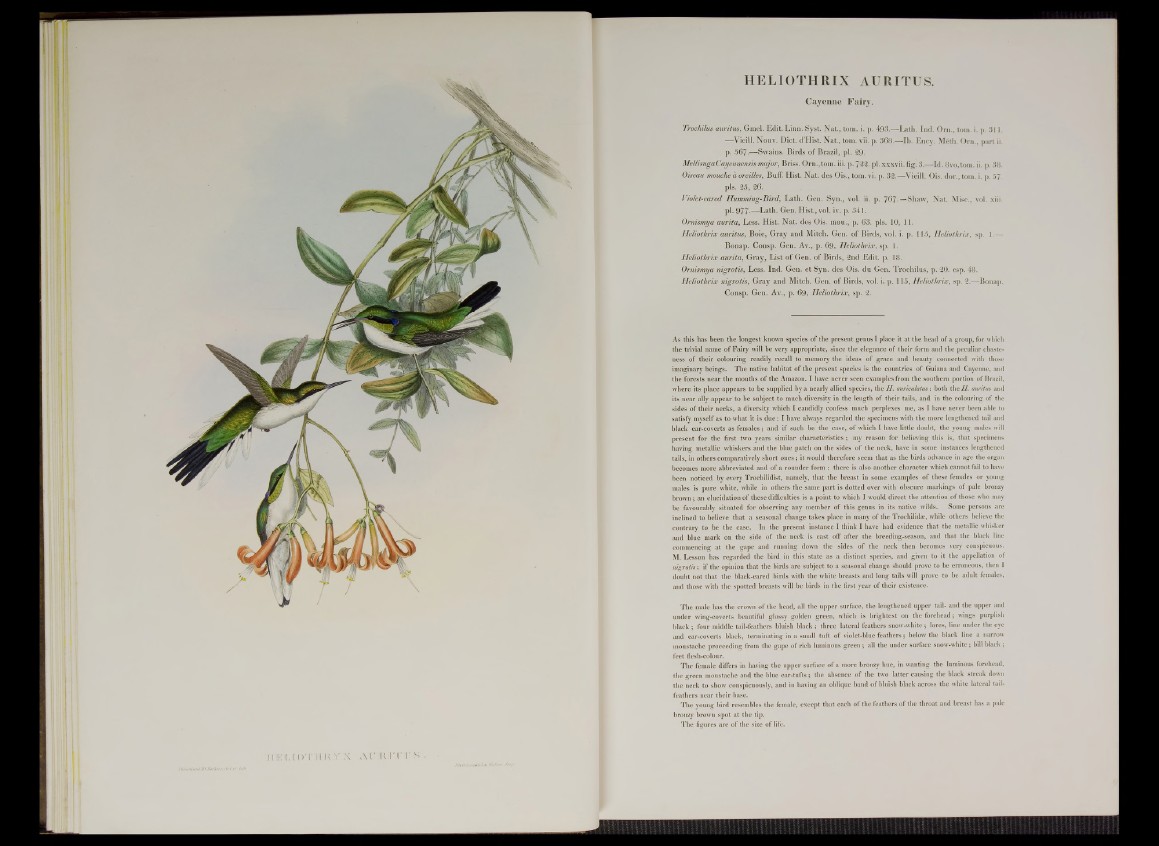
HELIOTHRIX AURITUS .
Cayenne Fairy.
Trochilus auritus, Gmel. Edit. Linn. Syst. Nat., tom. i. p. 493.—Lath. Ind. Orn., tom. i. p. 311.
—Vieill. Nouv. Diet. d’Hist. Nat., tom. vii. p. 368.—Ib. Ency. Meth. Orn., part ii.
p. 567-—Swains. Birds o f Brazil, pi. 29.
MellisugaCayennensis major, Briss. O rn.,tom. iii. p. 722. pi. xxxvii. fig. 3.—Id. 8vo,tom. ii. p. 38.
Oiseau moucke a oreilles, Buff. Hist. Nat. des Ois., tom. vi. p. 32.—Vieill. Ois. dor., tom. i. p. 57.
pis. 25, 26.
Violet-eared, Humming-Bird, Lath. Gen. Syn., vol. ii. p. 76 7 -— Shaw, Nat. Misc., vol. xiii.
pi. 977-—Lath. Gen. Hist., vol. iv. p. 341.
Ornismya aurita, Less. Hist. N a t. des Ois. mou., p. 63. pis. 10, 11.
Heliothrix auritus, Boie, Gray and Mitch. Gen. o f Birds, vol. i. p. 115, Heliothrix, sp. 1.—
Bonap. Consp. Gen. Av., p. 69, Heliothrix, sp. 1.
H eliothrix aurita, Gray, List o f Gen. o f Birds, 2nd Edit. p. 18.
Ornismya nigrotis, Less. Ind. Gen. e tS y n . des Ois. d u Gen. Trochilus, p. 20. esp. 48.
Heliothrix nigrotis, Gray and Mitch. Gen. o f Birds, vol. i. p. 115, Heliothrix, sp. 2.— Bonap.
Consp. Gen. Av., p. 69, Heliothrix, sp. 2.
As this has been the longest known species of the present genus I place it at the head of a group, for which
the trivial name of Fairy will be very appropriate, since the elegance of their form and the peculiar chasteness
of their colouring readily recall to memory the ideas of grace and beauty connected with those
imaginary beings. The native habitat of the present species is the countries of Guiana and Cayenne, and
the forests near the mouths of the Amazon. I have never seen examples from the southern portion of Brazil,
where its place appears to be supplied by a nearly allied species, the H. auriculatus: both the H. auritus and
its near ally appear to be subject to much diversity in the length of their tails, and in the colouring of the
sides of their necks, a diversity which I candidly confess much perplexes me, as I have never been able to
satisfy mvself as to what it is due: I have always regarded the specimens with the more lengthened tail and
black ear-coverts as females; and if such be the case, of which I have little doubt, the young males will
present for the first two years similar characteristics ; my reason for believing this is, that specimens
having metallic whiskers and the blue patch on the sides of the neck, have in some instances lengthened
tails, in others comparatively short ones; it would therefore seem that as the birds advance in age the organ
becomes more abbreviated and of a rounder form : there is also another character which cannot fail to have
been noticed by every Trochilidist, namely, that the breast in some examples of these females or young
males is pure white, while in others the same part is dotted over with obscure markings of pale bronzy
brown; an elucidation of these difficulties is a point to which I would direct the attention of those who may
be favourably situated for observing any member of this genus in its native wilds. Some persons are
inclined to believe that a seasonal change takes place in many of the Trochilidae, while others believe the
contrary to be the case. In the present instance I think I have had evidence that the metallic whisker
and blue mark on the side of the neck is cast off after the breeding-season, and that the black line
commencing at the gape and running down the sides of the neck then becomes very conspicuous.
HI Lesson has regarded the bird in this state as a distinct species, and given to it the appellation of
nigrotis: if the opinion that the birds are subject to a seasonal change should prove to be erroneous, then I
doubt not that the black-eared birds with the white breasts and long tails will prove to be adult females,
and those with the spotted breasts will be birds in the first year of their existence.
The male has the crown of the head, all the upper surface, the lengthened upper tail- and the upper and
under wing-coverts beautiful glossy golden green, which is brightest on the forehead; wings purplish
black ; four middle tail-feathers bluish black ; three lateral feathers snow-white; lores, line under the eye
and ear-coverts black, terminating in a small tuft of violet-blue feathers; below the black line a narrow
moustache proceeding from the gape of rich luminous green; all the under surface snow-white; bill black;
feet flesh-colour.
The female differs in having the upper surface of a more bronzy hue, in wanting the luminous forehead,
the green moustache and the blue ear-tufts ; the absence of the two latter causing the black streak down
the neck to show conspicuously, and in having an oblique band of bluish black across the white lateral tail-
feathers near their base.
The young bird resembles the female, except that each of the feathers of the throat and breast has a pale
bronzy brown spot at the tip.
The figures are of the size of life.